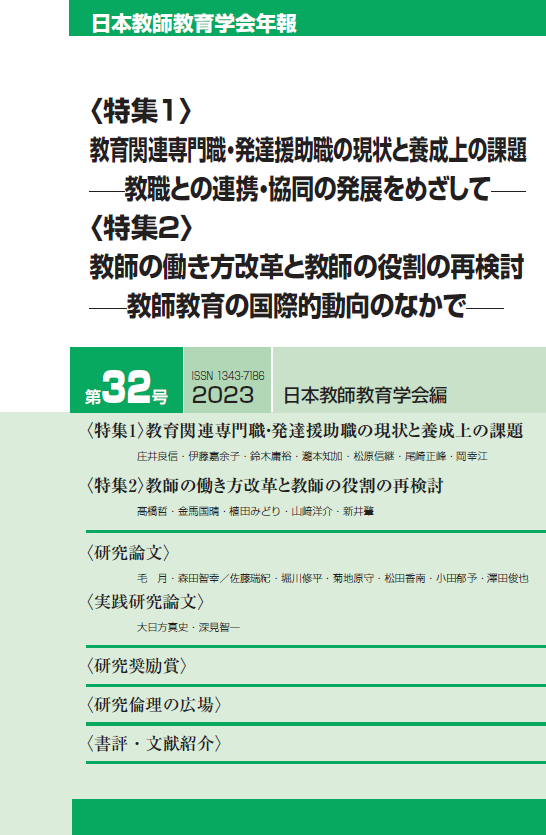Current issue
Displaying 1-37 of 37 articles from this issue
- |<
- <
- 1
- >
- >|
Cover
-
2024Volume 32 Pages 0
Published: 2024
Released on J-STAGE: July 04, 2025
Download PDF (334K)
-
2023Volume 32 Pages 9-19
Published: 2023
Released on J-STAGE: July 04, 2025
Download PDF (2402K) -
2023Volume 32 Pages 20-30
Published: 2023
Released on J-STAGE: July 04, 2025
Download PDF (3859K) -
2023Volume 32 Pages 31-44
Published: 2023
Released on J-STAGE: July 04, 2025
Download PDF (2687K) -
2023Volume 32 Pages 45-57
Published: 2023
Released on J-STAGE: July 04, 2025
Download PDF (2903K) -
2023Volume 32 Pages 58-70
Published: 2023
Released on J-STAGE: July 04, 2025
Download PDF (2972K) -
2023Volume 32 Pages 71-82
Published: 2023
Released on J-STAGE: July 04, 2025
Download PDF (2903K) -
2023Volume 32 Pages 83-94
Published: 2023
Released on J-STAGE: July 04, 2025
Download PDF (2542K)
-
2023Volume 32 Pages 97-109
Published: 2023
Released on J-STAGE: July 04, 2025
Download PDF (2840K) -
2023Volume 32 Pages 110-122
Published: 2023
Released on J-STAGE: July 04, 2025
Download PDF (2549K) -
2023Volume 32 Pages 123-134
Published: 2023
Released on J-STAGE: July 04, 2025
Download PDF (3521K) -
2023Volume 32 Pages 135-147
Published: 2023
Released on J-STAGE: July 04, 2025
Download PDF (3061K) -
2023Volume 32 Pages 148-158
Published: 2023
Released on J-STAGE: July 04, 2025
Download PDF (2891K)
-
2023Volume 32 Pages 160-172
Published: 2023
Released on J-STAGE: July 04, 2025
Download PDF (2907K) -
2023Volume 32 Pages 173-185
Published: 2023
Released on J-STAGE: July 04, 2025
Download PDF (2432K) -
2023Volume 32 Pages 186-198
Published: 2023
Released on J-STAGE: July 04, 2025
Download PDF (2901K) -
2023Volume 32 Pages 199-211
Published: 2023
Released on J-STAGE: July 04, 2025
Download PDF (2942K) -
2023Volume 32 Pages 212-224
Published: 2023
Released on J-STAGE: July 04, 2025
Download PDF (2901K) -
2023Volume 32 Pages 225-237
Published: 2023
Released on J-STAGE: July 04, 2025
Download PDF (2976K) -
2023Volume 32 Pages 238-250
Published: 2023
Released on J-STAGE: July 04, 2025
Download PDF (2937K)
-
2023Volume 32 Pages 252-264
Published: 2023
Released on J-STAGE: July 04, 2025
Download PDF (2980K) -
2023Volume 32 Pages 265-277
Published: 2023
Released on J-STAGE: July 04, 2025
Download PDF (2643K)
-
2023Volume 32 Pages 280-282
Published: 2023
Released on J-STAGE: July 04, 2025
Download PDF (2364K)
-
2023Volume 32 Pages 284-289
Published: 2023
Released on J-STAGE: July 04, 2025
Download PDF (2156K)
-
2023Volume 32 Pages 292-294
Published: 2023
Released on J-STAGE: July 04, 2025
Download PDF (1743K) -
2023Volume 32 Pages 295-297
Published: 2023
Released on J-STAGE: July 04, 2025
Download PDF (1741K) -
2023Volume 32 Pages 298-300
Published: 2023
Released on J-STAGE: July 04, 2025
Download PDF (1742K) -
2023Volume 32 Pages 301-303
Published: 2023
Released on J-STAGE: July 04, 2025
Download PDF (1748K) -
2023Volume 32 Pages 304
Published: 2023
Released on J-STAGE: July 04, 2025
Download PDF (1668K) -
2023Volume 32 Pages 305
Published: 2023
Released on J-STAGE: July 04, 2025
Download PDF (1647K) -
2023Volume 32 Pages 306
Published: 2023
Released on J-STAGE: July 04, 2025
Download PDF (1668K)
-
2023Volume 32 Pages 308-309
Published: 2023
Released on J-STAGE: July 04, 2025
Download PDF (1846K) -
2023Volume 32 Pages 310-311
Published: 2023
Released on J-STAGE: July 04, 2025
Download PDF (1937K) -
2023Volume 32 Pages 312-313
Published: 2023
Released on J-STAGE: July 04, 2025
Download PDF (1589K) -
2023Volume 32 Pages 314-315
Published: 2023
Released on J-STAGE: July 04, 2025
Download PDF (1589K)
-
2023Volume 32 Pages 347-349
Published: 2023
Released on J-STAGE: July 04, 2025
Download PDF (1382K)
Back cover
-
2024Volume 32 Pages 350-
Published: 2024
Released on J-STAGE: July 04, 2025
Download PDF (334K)
- |<
- <
- 1
- >
- >|
